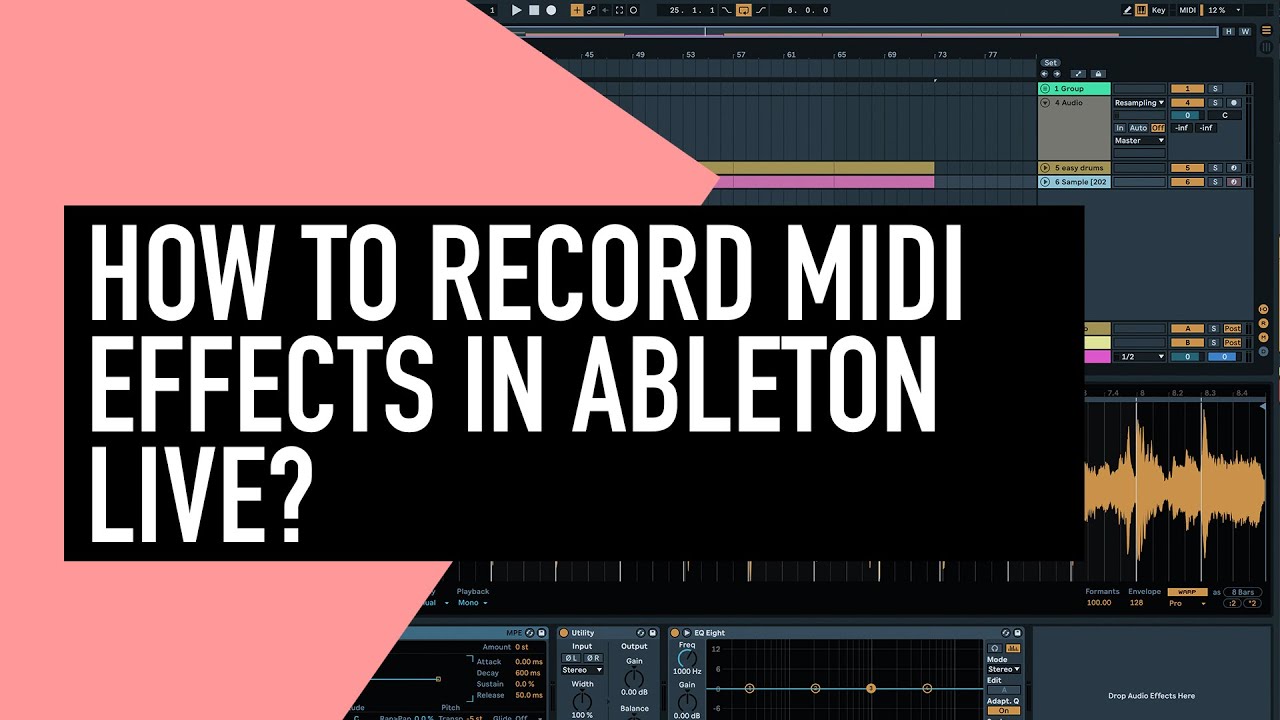
MIDI effects in Ableton Live are powerful tools that allow musicians, producers, and composers to manipulate, transform, and enhance MIDI data in real-time. Whether you’re creating complex melodies, harmonies, or rhythms, mastering the use of MIDI effects opens up a world of creative possibilities. In this extensive guide, we’ll explore every facet of using MIDI effects in Ableton Live, from understanding their capabilities to applying advanced techniques, empowering you to harness the full potential of MIDI and elevate your music to new heights.
Understanding MIDI Effects:
Before we delve into the specifics of using MIDI effects in Ableton Live, let’s establish a foundational understanding of what MIDI effects are and how they function:
- What are MIDI Effects? MIDI effects are software processors that manipulate MIDI data in real-time. Unlike audio effects, which process audio signals, MIDI effects operate on MIDI note and controller data, allowing for the manipulation of pitch, timing, velocity, and other musical parameters.
- Types of MIDI Effects: There are several types of MIDI effects available in Ableton Live, each serving a different purpose:
- Arpeggiator: Generates rhythmic patterns by automatically cycling through a sequence of MIDI notes.
- Chord: Transforms single MIDI notes into chords by adding additional notes based on user-defined intervals.
- Scale: Constrains MIDI notes to a specific musical scale, ensuring that only notes within the selected scale are output.
- Note Length: Adjusts the length of MIDI notes, allowing for precise control over note duration and timing.
- Velocity: Modifies the velocity (loudness) of MIDI notes, allowing for dynamic expression and articulation.
- Integration with Ableton Live: MIDI effects can be added to MIDI tracks or MIDI instruments in Ableton Live, allowing for real-time processing and manipulation of MIDI data. They can be chained together in series or parallel to create complex MIDI processing chains and effects.
Getting Started with MIDI Effects:
Now that we have a solid understanding of MIDI effects, let’s explore how to get started with using them in Ableton Live:
- Adding MIDI Effects to Tracks:
- To add a MIDI effect to a MIDI track or instrument, simply drag and drop it from the browser onto an empty MIDI track or instrument rack slot.
- Once added, the MIDI effect’s interface will appear, allowing you to adjust its parameters and settings to achieve the desired effect.
- Configuring MIDI Effects:
- Configure the parameters of MIDI effects to achieve the desired musical effect. For example, adjust the rate and pattern of an arpeggiator, define the intervals of a chord effect, or select the desired scale in a scale effect.
- Experiment with different settings and parameters to explore the sonic possibilities of each MIDI effect and how they interact with your musical ideas.
- Routing MIDI Effects:
- MIDI effects can be routed in series or parallel with other MIDI effects or instruments to create complex processing chains and effects.
- Use Ableton Live’s routing options to configure the signal flow and processing order of MIDI effects, allowing for precise control over the manipulation and transformation of MIDI data.
Advanced Techniques and Workflow Tips:
Now that we’ve covered the basics of using MIDI effects in Ableton Live, let’s explore some advanced techniques and workflow tips to enhance your productivity and creativity:
- Creative MIDI Processing Chains:
- Experiment with chaining multiple MIDI effects together to create unique and expressive musical effects. Combine arpeggiators, chord effects, and scale effects to create complex harmonic and melodic patterns.
- Use MIDI effects in combination with MIDI controllers and automation to create dynamic and evolving performances that respond to your input in real-time.
- MIDI Effect Racks:
- Utilize MIDI effect racks to create custom MIDI processing chains and presets. Group multiple MIDI effects together into a rack and save it as a preset for easy recall and reuse in future projects.
- Explore macro controls and mapping to create expressive performance controls that allow you to manipulate multiple MIDI effects parameters simultaneously.
- Live Performance and Composition:
- Incorporate MIDI effects into your live performance setups and composition workflows to inspire creativity and experimentation. Use MIDI effects to generate musical ideas, explore harmonic progressions, and generate rhythmic patterns on the fly.
- Combine MIDI effects with virtual instruments and audio effects to create dynamic and immersive live performances that captivate your audience and push the boundaries of your creativity.
Integrating MIDI Effects into Your Workflow:
As you become more comfortable with using MIDI effects in Ableton Live, consider integrating them into your overall music production workflow in the following ways:
- Composition and Arrangement:
- Use MIDI effects to generate musical ideas, explore harmonic progressions, and experiment with rhythmic patterns during the composition and arrangement phases of your projects.
- Incorporate MIDI effects into your workflow to overcome creative blocks, spark inspiration, and discover new musical possibilities.
- Sound Design and Texture Creation:
- Explore the creative potential of MIDI effects for sound design and texture creation. Experiment with arpeggiators, chord effects, and scale effects to generate unique and expressive soundscapes and atmospheres.
- Use MIDI effects in combination with virtual instruments and audio effects to create rich, layered textures and intricate sonic landscapes.
- Live Performance and Improvisation:
- Incorporate MIDI effects into your live performance setups and improvisational workflows to create dynamic and engaging performances. Use MIDI controllers and automation to manipulate MIDI effects parameters in real-time, allowing for spontaneous improvisation and creativity on stage.
Conclusion:
MIDI effects in Ableton Live are powerful tools for manipulating, transforming, and enhancing MIDI data in real-time. By mastering their features, techniques, and workflow, you’ll unlock a world of creative possibilities for music production, composition, and live performance.
Whether you’re creating complex melodies, harmonies, or rhythms, MIDI effects in Ableton Live provide the tools and flexibility needed to bring your musical ideas to life with precision and flair. So, dive in, experiment, and let the boundless creativity of MIDI effects inspire your musical journey in Ableton Live!